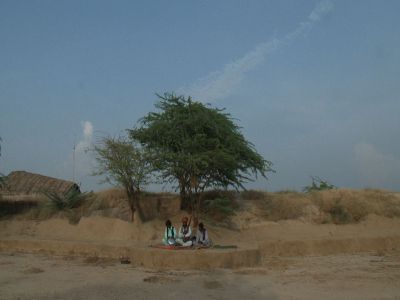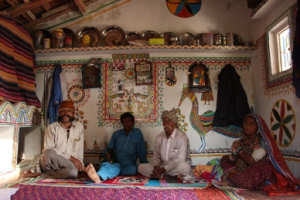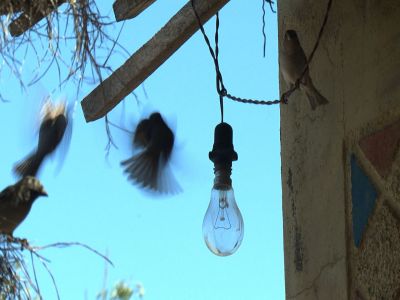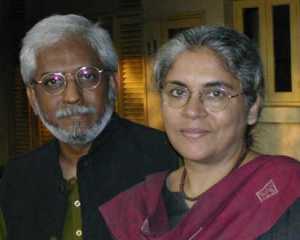Do Din Ka Mela (A Two Day Fair)
August 21, 2009

Directed by KP Jayasankar and Anjali Monteiro
2009, Kutchi and Gujarati with English subtitles, 61 mins.
Camera: KP Jayasankar, Script, Editing, Sound Design: Anjali Monteiro and KP Jayasankar
Produced by the Centre for Media and Cultural Studies, Tata Institute of Social Sciences, Mumbai, India
www.cmcs.tiss.edu
Enquiries: sales.cmcs[AT]tiss.edu
“Nothing in the world will last – it is but a two day fair” sings Mura Lala Fafal, drawing inspiration from the Sufi traditions of Sant Kabir and Abdul Lateef Bhita’i. He is accompanied on the Jodiya Pava (double flute) by his nephew Kanji Rana Sanjot. Kanji taught himself to play and make his own flutes after hearing the music on the radio. Mura and Kanji are Meghwals, a pastoral Dalit community that lives on the edge of the Great Rann of Kutch, in the Western Indian state of Gujarat. They are both daily wage labourers and subsistence farmers in an arid zone. The film is a a two day journey into the music and every day life of this uncle-nephew duo, set against the backdrop of the Rann.

The Great Rann of Kutch is a vast salt marsh/desert that separates India and Pakistan. Before the Partition the Meghwals moved freely across the Rann, between Sindh (now in Pakistan) and Kutch. The music and culture of the region is a rich tapestry of many traditions and faiths, an affirmation of the syncretic wisdom of the marginalised comunities that live in this spectacular and yet fragile area.
A Two Day Fair on Facebook (Click here)
Awards
Indian Documentary Producers’ Association 2009 : Gold for the Best Script and Certificate of Merit for the Best Documentary
Commendation in the Intangible Culture (Music-Dance-Performance) category at the 12th RAI International Festival of Ethnographic Film 2011 (http://raifilmfest.org.uk/film/festival/2011/home/winners)
Festival Selections
Jean Rouch International film Festival, Paris 2010
(http://www.comite-film-ethno.net/)
Goettingen International Film Festival, Germany 2010
(http://www.gieff.de/)
JDCA Festival on Art and Artists, Orissa, India, 2010
( http://jdcafilmfestival.org/photogallery.html )
Vibgyor Film festival, Kerala, India, 2010
(http://www.vibgyorfilm.org/)
3rd International Documentary and Short Film Festival of Kerala
Zanzibar International Film Festival
(http://www.ziff.or.tz/films)
Sardinia International Ethnographic Film Festival 2010
(http://sieff.isresardegna.it)
Viscult 2010, Joensuu, Finland
(http://www.pkey.fi/viscult/2010/)
13th Istanbul International 1001 Documentary Film Festival
(http://www.1001belgesel.net/en/)
Royal Anthropological Institute Film Festival 2011
(http://raifilmfest.org.uk/film/festival/2011/home/programme-78)
Reviews
Fr. Gaston Roberge
Do din ka mela
22 January 2010
And I realized the film was over
I was lost in it
Feeling proud of being a human
Discovering God anew
What are we doing in our big cities?
With our technological achievements?
Sweet people are rare today
Yet it is all a matter of fate
The landscape
The houses
The village
The animals
And the people
Men women children
They all seem to live within themselves
And yet are in communion with all
People, stones, water, field, birds, sand, herbs
I am so happy to be one of them
Thanks to that medium
And I feel so thankful to Anjali and Jayasankar
The people in the film
Are happy that others will come to know them
They are right
There is extended communion with them
Throughout the music lifts you to another level
Where you are more fully yourself
A music that a young man
Discovered in his heart
There are also the colors
The designs in the houses
On the garments
All has a human touch
And the human is divine
In that he communes with Him
Ishwar and Allah
It takes time
So the images are dwelt upon
For some time
In some detail
Whether a bird, a leaf on a tree
A goat a camel or a cow
Going its way in the infinite horizon
And looking at you inquisitively
Or inviting you to join on a journey?
———————————————————-
The Silent Songs Of The DesertPRAGYA TIWARIhttp://www.tehelka.com/story_main44.asp?filename=c200310the_silent.asp
“WILL THIS film benefit us, you think?” Mura Lala Fafal asks his brother. “The world will see how little we have and how we embrace our life,” he answers, “if they understand”. KP Jayasankar and Anjali Monteiro’s Two Day Fair is a chronicle of two days in the lives of Mura and his nephew Kanji — musicians, wage labourers and farmers of the Dalit community of Meghwals living along the Indo-Pak border in the Rann of Kutch. With any such film, the primary benefit is always to the audience who engages with a world so starkly different from theirs, interfaced by the filmmakers’ inherently limited interpretation of it. Monteiro and Jayasankar present the two lives as an aesthete’s portrait, casting the long, languid gaze of an outsider through their camera. The viewer enraptured by the landscape, music and innate beauty of the people, is agreeably not offered an easily palatable narrative of lament or pity. The subjects are poor, exploited, discarded by the democracy that was shaped by carving out a large section of their native land into an enemy state. But they also live outside its maladies — like Mura points out quietly — “We don’t have diseases here. We don’t consume what the TV tells us to consume. There are no goods here, no advertisements.” Woven with the camera’s unmistakable love for the landscape, these words tinge our understanding with a sense of longing and distance that is a necessary antidote to clichéd ways of looking across the rural-urban divide. While Mura and Kanji talk about their passion for music, visuals of them toiling hard for a meagre wage grate in contrast. On cue, the desert fills in to lend the music an irreplaceable context. A perfect backdrop for what the film leaves out of its scope — the articulation of issues that confront folk singers. The art is endangered by a number of factors augmented by rapid changes in a modernising society that is not willing to compensate enough. If the culture is to survive, a sustainable model for preservation and growth has to be set up as a self-sufficient creative economy in their native lands. This case argues itself when you hear Mura explain the words of Sufi and Bhakti saints, his tattered garb transforming itself from a testimony of destitution to the pride of a minstrel. They have Kabir. We have his songs on a CD. |
||
|
From Tehelka Magazine, Vol 7, Issue 11, Dated March 20, 2010
|
||
———————————————————-
Ahmedabad, Jan 20, 2010
City’s date with Kutch: ‘Do din ka Mela’
The documentary was screened with an aim to educate
Amdavadis about the rich Kutchi culture and its music
Caroline Andrade
The colours of Kutch came to Ahmedabad in the form of a one-hour documentary titled ‘Do din ka Mela’. The screening of the documentary was held at the Nirman Bhavan, opposite British Library on Monday. With the aim to provide Amdavadis a chance to learn about the culture, lifestyle and most importantly music of the Kutch populace, two professors from the Tata Institute of Social Sciences, Mumbai, jointly directed the docu.
The directors, Dr Anjali Monteiro and Dr KP Jayasankar, were also present at the film screening which was followed by an hour long discussion with the audience.”The film is a musical series done in collaboration with the Kutch Mahila Vikas Sangatttan for which we have worked with a Dalit community called ‘Meghwals’. The film talks about two musicians one of whom is a singer called Mura Lala who is involved in a lot of Sufi music along with songs by Kabir and the other is his nephew, Kanji Rana who plays the double flute. It is a two-day journey of the duo that is set in Kutch,”explained Monteiro.
She added, “The idea is to show the wisdom and tolerance of the people living in areas of the Rann of Kutch that come alive with music and also the way in which music plays an important part in their life. Sufi music provides the message of tolerance and talks about examining one’s own consciousness, besides being in harmony with one’s own self.”
The film had its first screening in Ahmedabad and was attended by about 100 people including students, activists, artists, professors, and film makers. Monteiro added: “The film makes an attempt at showing the philosophy of Nirgun which means peace. We have a lot to learn from the poor and their music.”
———————————————————-
A Fair Play
| A new documentary about music, Kutch and survival | |
|
|
|
The latest documentary from Anjali Monteiro and KP Jayasankar is about sounds of survival. In Do Din Ka Mela, Monteiro and Jayasankar bring us the folk music of the Rann of Kutch. The filmmakers, who also teach at the Centre for Media and Cultural Studies at the Tata Institute of Social Sciences, record the songs and the lives of Mura Lala Fafal and his nephew Kanji Rana Sanjot. There are several layers to the music of the two men, who are from the Dalit Meghwal community. For the filmmakers, the songs represent a spiritual quest as well as a time-tested secular tradition. The Rann borders Pakistan, and before Partition, the Meghwals would freely cross over to Sindh, which is now in Pakistan.
How did the film come about? Anjali Monteiro: In March 2008, we started looking at community radio and the work of the Kutch Mahila Vikas Sangathan. We found an interesting network of grassroots musicians that the KMVS had formed. We found musical forms and instruments whose use was dying. Do Din Ka Mela is the first in a series of films on these musicians.
How did you decide to use the music in the documentary?
Monteiro: The idea is of music affecting the texture of everyday life. Music proved easier to shoot than poetry or painting. We looked for the rhythm of the everyday – such as cooking, or grazing cows or embroidery. We tried to maintain a dignified pace and not hurry anything. We also wanted to look at the syncretic culture of the region. Earlier, for instance, all the men, Hindu and Muslim, wore Pathani suits. Nowadays, the Hindus have started wearing pants and shirts.
The documentary makes the point that the musicians represent a syncretic culture. Is this too romantic a view?
KP Jayasankar: Sure, you can’t glamourise that culture or valourise syncretism. Kutch is an area of great turmoil. It is also very patriarchal. But it would be glib to say that everything is fine. Even in Kutch, a process of polarisation has taken place. We wanted visible forms of secular culture, particularly in a state like Gujarat.
Monteiro: Historically, the constant movement made for an ability to draw from certain cultures. There is an absence of a monolithic culture that sees one way as right. The music comes from different traditions. That is there in people like Mura Lala at a gut level.
How did the Meghwals react?
Jayasankar: We held our first screening at Mura’s village. The villagers felt honoured that their tradition had been documented. The voltage was low, and the sound kept coming and going. When a stray dog saw one of the goats on screen, he jumped at the screen and barked. Nandini Ramnath
|
|
| Source : Time Out Mumbai ISSUE 8 Friday, December 11, 2009 |
About the Directors
Anjali Monteiro and K.P. Jayasankar are Professors at the Centre for Media and Cultural Studies, Tata Institute of Social Sciences, Mumbai. Monteiro has a Masters degree in Economics and a Ph.D. in Sociology. Jayasankar has an M.A. in German language and a Ph.D. in Humanities and Social Sciences. Both of them are involved in media production, teaching and research. A presiding thematic of much of their work has been a problematising of notions of self and the other, of normality and deviance, of the local and the global, through the exploration of diverse narratives and rituals. These range from the stories and paintings of indigenous peoples to the poetry of prison inmates. Jointly they have won twenty three national and international awards for their films. These include the Prix Futura Berlin 1995 Asia Prize for Identity- The Construction of Selfhood, Best Innovation, Astra Film Festival 1998, Sibiu, Romania for YCP 1997, Best documentary award at the IV Three Continents International Festival of Documentaries 2005, Venezuela, for SheWrite ,Certificate of Merit, Mumbai International Film Festival 2008, Indian Documentary Producers Associuation (IDPA) Gold for Best Sound Design, Gold for Best Script and Silver for Editing for the film Our Family. Their most recent award is the commendation for Do Din Ka Mela (A Two Day Fair) in the Intangible Culture (Music-Dance-Performance) category at the 12th RAI International Festival of Ethnographic Film . Vibgyor Film Festival, Kerala and Bangalore Film Society have organised retrospectives of their work in 2006 and 2010, respectively.
They have several papers in the area of media and cultural studies and have contributed to scholarly journals such as Cultural Studies. They are both recipients of the Howard Thomas Memorial Fellowship in Media Studies, and have been attached to Goldsmith’s College, London and the University of Western Sydney. Monteiro has been awarded a Fulbright visiting lecturer fellowship for 2006-07 at the University of California, Berkeley. They also serve as visiting faculty to several leading media and design institutions in India and abroad. They are both actively involved in ‘Vikalp‘ and ‘Films for Freedom’, which are collectives of documentary filmmakers campaigning for freedom of expression. They are also associated with various media and voluntary organisations.

———————————————————-
Mathrubhoomi Malayalam Newspaper
http://frames.mathrubhumi.com/story.php?id=88414
Mumbai, March 11. 2010
സൂഫിസംഗീതത്തിന്റെ പൊരുള് തേടി ‘ദോ ദിന്കാ മേള‘
മുംബൈ: ഇന്ത്യയും പാകിസ്താനും തമ്മില് അതിര്വരമ്പുകള് തീര്ത്ത് വ്യത്യസ്ത രാജ്യങ്ങളായി നിലകൊള്ളുമ്പോഴും സൂഫിസംഗീതത്തിന്റെ സാംസ്കാരികധാര ഇരുരാജ്യങ്ങളുടെയും ഹൃദയത്തിലുണ്ട്.
അത്തരമൊരന്വേഷണത്തിന്റെ പൂര്ത്തീകരണമാണ് ടാറ്റ ഇന്സ്റ്റിറ്റിയൂട്ട് ഓഫ് സോഷ്യല് സയന്സിലെ അധ്യാപകരായ ഡോക്ടര് കെ.പി. ജയശങ്കറും ഡോക്ടര് അഞ്ജലി മോണ്ടോറിയവും ചേര്ന്ന് നിര്മിച്ച ഡോക്യുമെന്ററി ‘ദോ ദിന് കാ മേള‘

ഗുജറാത്തിലെ കച്ച് പ്രദേശം പാകിസ്താന്റെ അതിര്ത്തിയാണ്. മരുഭൂമിയും ചതുപ്പും ചേര്ന്ന ഈ പ്രദേശമാണ് രാജ്യങ്ങളെ വിഭജിക്കുന്നത്. റാന് ഓഫ് കച്ചില് ജീവിക്കുന്ന മേഘ്വാലാസ് എന്ന ദളിത് സമൂഹത്തിലൂടെ സൂഫിസംഗീതത്തിന്റെ കൈവഴികളും അതിന്റെ സാംസ്കാരികധാരകളും വീണ്ടെടുക്കുകയാണ ‘ദോ ദിന് കാ മേള‘. ഗുജറാത്തിലെ റാന് ഓഫ് കച്ചില് നിലനില്ക്കുന്ന സംഗീതധാര, പാകിസ്താനിലെ സിന്ധ് പ്രദേശത്തിന്റെ ഹൃദയത്തിലുമുണ്ട്. മുറലാലയിലൂടെയും മറ്റ് സംഗീത കലാകാരന്മാരിലൂടെയും സൂഫിസംഗീതസഞ്ചാരവും അവരുടെ ജീവിതവും ഈ ഡോക്യുമെന്ററിയുടെ ഭാഗമാവുകയാണ്.
ഈ വര്ഷം പാരീസില് നടന്ന ജീന് റോച്ച് അന്താരാഷ്ട്ര ചലച്ചിത്രമേള, ജര്മനിയില് നടന്ന ജോട്ടിഗേര് ഇന്റര്നാഷണല് ഫിലിംഫെസ്റ്റര്, ഒറീസ്സയില് നടന്ന ജെ.ഡി.സി.എ. ഫെസ്റ്റിവല് ഓണ് ആര്ട്സ് ആന്ഡ് ആര്ട്ടിസ്റ്റ്സ്, തൃശ്ശൂരില് നടന്ന വിബ്ജിയോര് ചലച്ചിത്രമേള എന്നീ മേളകളില് ഈ ചിത്രം പ്രദര്ശിപ്പിച്ചുകഴിഞ്ഞു.കച്ച് മഹിളാ വികാസ് സംഘടനയുടെ സഹായത്തോടെ നിര്മിച്ച ഈ ചിത്രം കച്ചിന്റെ പ്രകൃതിയും ജീവിതവും സംഗീതവും ഇടകലര്ന്ന് മറ്റൊരു ദൃശ്യഭംഗി നല്കുന്നുണ്ട്. ഡോക്യുമെന്ററി രംഗത്ത് പ്രശസ്തരായ കെ.പി. ജയശങ്കറിന്റെയും അഞ്ജലി മോണ്ടോറിയയുടെയും ഏറ്റവും പുതിയ ഡോക്യുമെന്ററിയാണിത്.
————————————————————
CREDITS
Interview Translation
Swati Gada
Sujeet Bhatt
Preetben Soni
Subuhi Jiwani
Production Assistance and Stills
Mangesh Gudekar
Editing,Sound Design and Subtitles
K.P. Jayasankar
Anjali Monteiro
Location Sound
Harikumar M.
Camera
K. P. Jayasankar
Script and Direction
Anjali Monteiro
K. P. Jayasankar
In collaboration with Kutch Mahila Viaks Sanghatan
Produced by
Centre for Media and Cultural Studies
Tata Institute of Social Sciences
Mumbai 400 088, India
Telephone: +91 22 25525667
E-mail: cmcs.tiss[AT] gmail[DOT]com URL: www.cmcs.tiss.edu
| *Fair play | |
|
A new documentary about music, Kutch and survival.
The latest documentary from Anjali Monteiro and KP Jayasankar is about sounds of survival. In Do Din Ka Mela, Monteiro and Jayasankar bring us the folk music of the Rann of Kutch. The filmmakers, who also teach at the Centre for Media and Cultural Studies at the Tata Institute of Social Sciences, record the songs and the lives of Mura Lala Fafal and his nephew Kanji Rana Sanjot. There are several layers to the music of the two men, who are from the Dalit Meghwal community. For the filmmakers, the songs represent a spiritual quest as well as a time-tested secular tradition. The Rann borders Pakistan, and before Partition, the Meghwals would freely cross over to Sindh, which is now in Pakistan. How did the film come about? Anjali Monteiro: In March 2008, we started looking at community radio and the work of the Kutch Mahila Vikas Sangathan. We found an interesting network of grassroots musicians that the KMVS had formed. We found musical forms and instruments whose use was dying. Do Din Ka Mela is the first in a series of films on these musicians.
How did you decide to use the music in the documentary?
Monteiro: The idea is of music affecting the texture of everyday life. Music proved easier to shoot than poetry or painting. We looked for the rhythm of the everyday – such as cooking, or grazing cows or embroidery. We tried to maintain a dignified pace and not hurry anything. We also wanted to look at the syncretic culture of the region. Earlier, for instance, all the men, Hindu and Muslim, wore Pathani suits. Nowadays, the Hindus have started wearing pants and shirts.
The documentary makes the point that the musicians represent a syncretic culture. Is this too romantic a view?
KP Jayasankar: Sure, you can’t glamourise that culture or valourise syncretism. Kutch is an area of great turmoil. It is also very patriarchal. But it would be glib to say that everything is fine. Even in Kutch, a process of polarisation has taken place. We wanted visible forms of secular culture, particularly in a state like Gujarat.
Monteiro: Historically, the constant movement made for an ability to draw from certain cultures. There is an absence of a monolithic culture that sees one way as right. The music comes from different traditions. That is there in people like Mura Lala at a gut level.
How did the Meghwals react?
Jayasankar: We held our first screening at Mura’s village. The villagers felt honoured that their tradition had been documented. The voltage was low, and the sound kept coming and going. When a stray dog saw one of the goats on screen, he jumped at the screen and barked. Nandini Ramnath
|
|
| Source : Time Out Mumbai ISSUE 8 Friday, December 11, 2009 |






